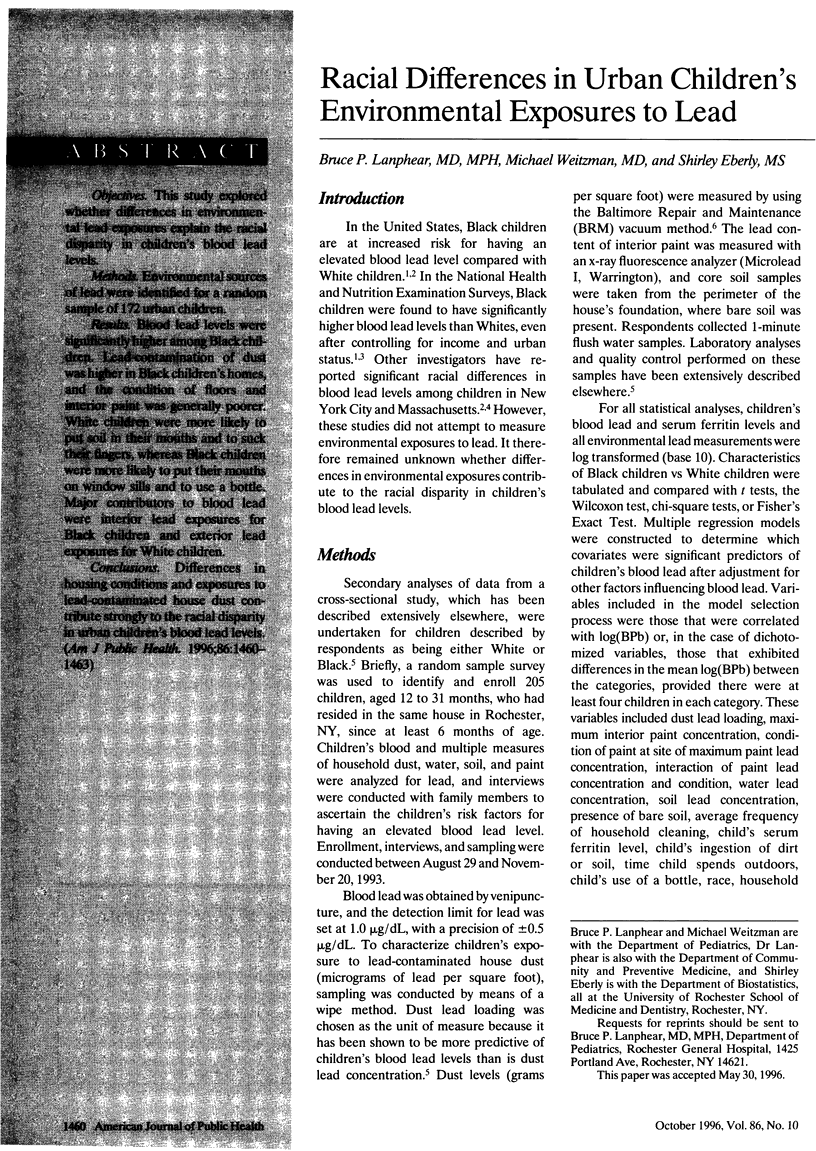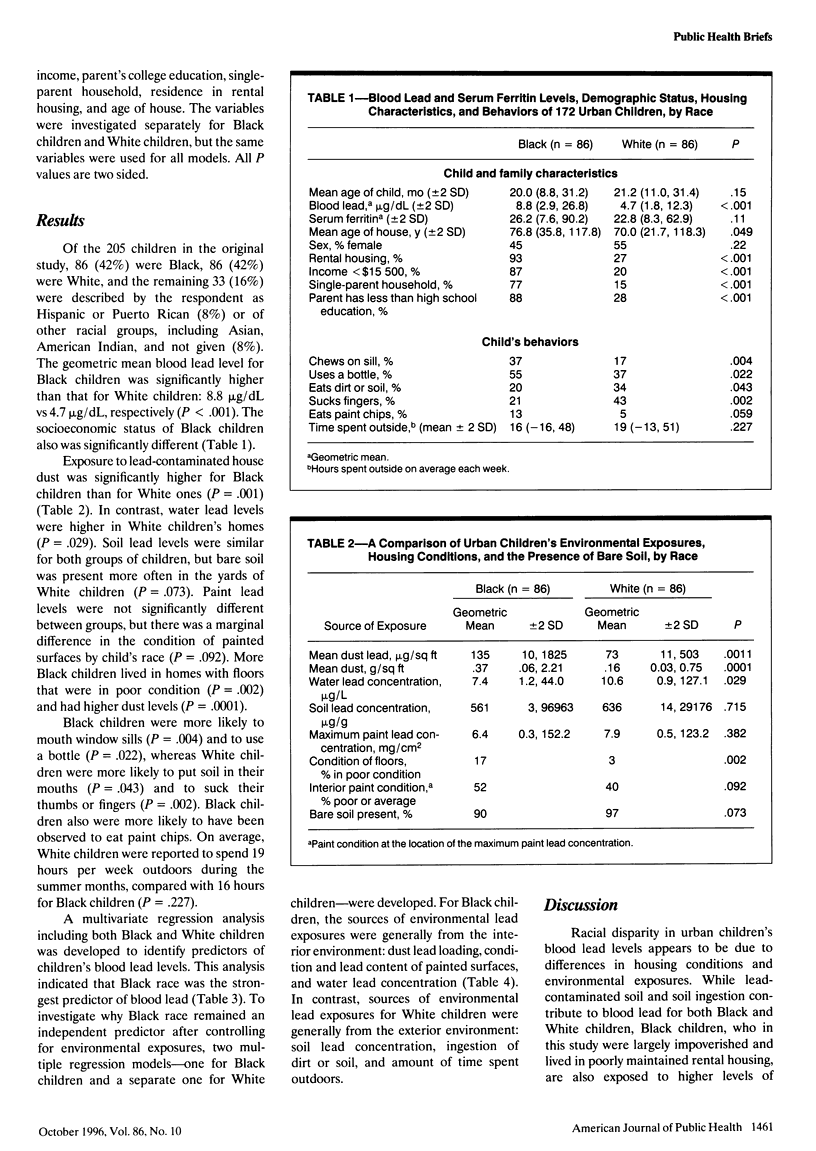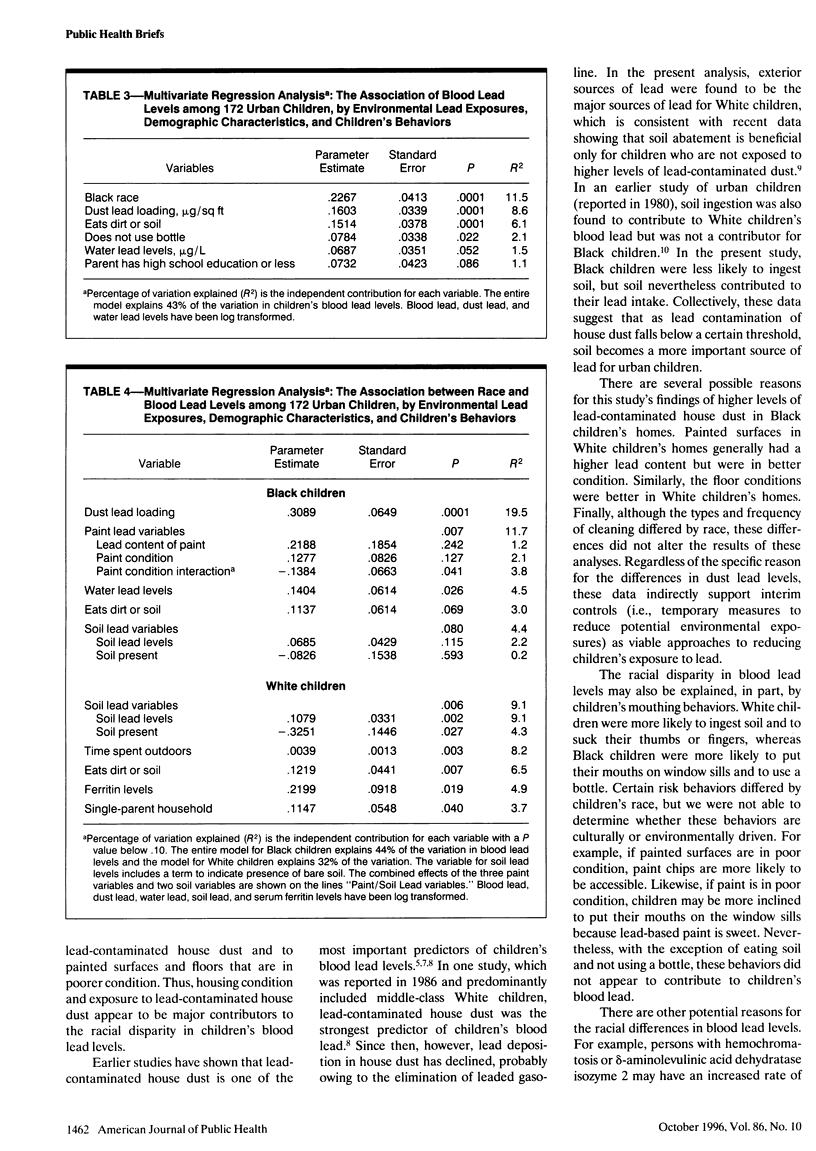Abstract
OBJECTIVES: This study explored whether differences in environmental lead exposures explain the racial disparity in children's blood lead levels. METHODS: Environmental sources of lead were identified for a random sample of 172 urban children. RESULTS: Blood lead levels were significantly higher among Black children. Lead-contamination of dust was higher in Black children's homes, and the condition of floors and interior paint was generally poorer. White children were more likely to put soil in their mouths and to suck their fingers, whereas Black children were more likely to put their mouths on window sills and to use a bottle. Major contributors to blood lead were interior lead exposures for Black children and exterior lead exposures for White children. CONCLUSIONS: Differences in housing conditions and exposures to lead-contaminated house dust contribute strongly to the racial disparity in urban children's blood lead levels.
Full text
PDF



Selected References
These references are in PubMed. This may not be the complete list of references from this article.
- Aschengrau A., Beiser A., Bellinger D., Copenhafer D., Weitzman M. The impact of soil lead abatement on urban children's blood lead levels: phase II results from the Boston Lead-In-Soil Demonstration Project. Environ Res. 1994 Nov;67(2):125–148. doi: 10.1006/enrs.1994.1069. [DOI] [PubMed] [Google Scholar]
- Astrin K. H., Bishop D. F., Wetmur J. G., Kaul B., Davidow B., Desnick R. J. delta-Aminolevulinic acid dehydratase isozymes and lead toxicity. Ann N Y Acad Sci. 1987;514:23–29. doi: 10.1111/j.1749-6632.1987.tb48757.x. [DOI] [PubMed] [Google Scholar]
- Barton J. C., Patton M. A., Edwards C. Q., Griffen L. M., Kushner J. P., Meeks R. G., Leggett R. W. Blood lead concentrations in hereditary hemochromatosis. J Lab Clin Med. 1994 Aug;124(2):193–198. [PubMed] [Google Scholar]
- Bellinger D., Leviton A., Rabinowitz M., Needleman H., Waternaux C. Correlates of low-level lead exposure in urban children at 2 years of age. Pediatrics. 1986 Jun;77(6):826–833. [PubMed] [Google Scholar]
- Billick I. H., Curran A. S., Shier D. R. Analysis of pediatric blood lead levels in New York City for 1970-1976. Environ Health Perspect. 1979 Aug;31:183–190. doi: 10.1289/ehp.7931183. [DOI] [PMC free article] [PubMed] [Google Scholar]
- Blake K. C., Mann M. Effect of calcium and phosphorus on the gastrointestinal absorption of 203Pb in man. Environ Res. 1983 Feb;30(1):188–194. doi: 10.1016/0013-9351(83)90179-2. [DOI] [PubMed] [Google Scholar]
- Brody D. J., Pirkle J. L., Kramer R. A., Flegal K. M., Matte T. D., Gunter E. W., Paschal D. C. Blood lead levels in the US population. Phase 1 of the Third National Health and Nutrition Examination Survey (NHANES III, 1988 to 1991) JAMA. 1994 Jul 27;272(4):277–283. doi: 10.1001/jama.272.4.277. [DOI] [PubMed] [Google Scholar]
- Charney E., Sayre J., Coulter M. Increased lead absorption in inner city children: where does the lead come from? Pediatrics. 1980 Feb;65(2):226–231. [PubMed] [Google Scholar]
- Lanphear B. P., Emond M., Jacobs D. E., Weitzman M., Tanner M., Winter N. L., Yakir B., Eberly S. A side-by-side comparison of dust collection methods for sampling lead-contaminated house dust. Environ Res. 1995 Feb;68(2):114–123. doi: 10.1006/enrs.1995.1015. [DOI] [PubMed] [Google Scholar]
- Mahaffey K. R., Annest J. L., Roberts J., Murphy R. S. National estimates of blood lead levels: United States, 1976-1980: association with selected demographic and socioeconomic factors. N Engl J Med. 1982 Sep 2;307(10):573–579. doi: 10.1056/NEJM198209023071001. [DOI] [PubMed] [Google Scholar]
- Mahaffey K. R., Gartside P. S., Glueck C. J. Blood lead levels and dietary calcium intake in 1- to 11-year-old children: the Second National Health and Nutrition Examination Survey, 1976 to 1980. Pediatrics. 1986 Aug;78(2):257–262. [PubMed] [Google Scholar]
- Sargent J. D., Brown M. J., Freeman J. L., Bailey A., Goodman D., Freeman D. H., Jr Childhood lead poisoning in Massachusetts communities: its association with sociodemographic and housing characteristics. Am J Public Health. 1995 Apr;85(4):528–534. doi: 10.2105/ajph.85.4.528. [DOI] [PMC free article] [PubMed] [Google Scholar]


